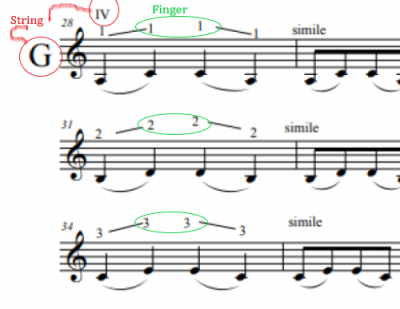Welcome to our forum. A Message To Our New and Prospective Members . Check out our Forum Rules. Lets keep this forum an enjoyable place to visit.
Currently working on errors from the latest (SimplePress) forum update. Many issues have been resoled and others are being worked on. Thank you for your patience.
 Topic RSS
Topic RSS



 (0 votes)
(0 votes) Regulars


Lately I've been working more towards the 3rd and 4th position, primarily shifting scales and first finger shifts (from 1th to 3rd.). I'm starting to become familiar with these exercises and want to work on something a little more advanced. Is there any good etudes that focus on shifting?
'Armed with theory, practice becomes meaningful. Through practice, theory becomes fulfilled.' - Egon von Neindorff.
Regulars


Regulars
 Offline
Offline






Fiddlerman said
I'm sure are great etudes available but you can also use 3rd and 4th positions on any piece you are working on just to get used to playing in positions.I wrote this out for 3rd position:
https://fiddlerman.com/wp-cont.....Smears.pdf
@fiddlerman the numbers above the staff refer to fingers to use correct? Roman numerals indicate the position we would be in? Also, we arent meant to have any notes played when we slide the finger Im guessing. Its not a greasy "chicken reel" kinda thing..just a quick move into position without the bow moving?
@hp hope you dont mind me hijacking your question. Thanks for asking this. Its good timing. We have a tune we started today that has some position shifts. Just havent gotten into the position shifting on it yet. Maybe I can get a little more familiar with shifting before next class. Thanks!
Regulars


Regulars










Regulars
 Offline
Offline



 Like @Jim Dunleavy said the Roman numerals indicate the the string, in this example the string is also indicated by its note letter "G", etc. The Arabic numerals indicate the finger to use.
Like @Jim Dunleavy said the Roman numerals indicate the the string, in this example the string is also indicated by its note letter "G", etc. The Arabic numerals indicate the finger to use.
This is a practice involving starting from the 1st position and sliding to the third position on the same finger. (1st finger on G string in 1st position is "A" slides up to "C" for the 3rd position).
I like the Whistler books on positions, but find they progress a bit too rapidly 🙂
I'm still trying to learn all the positions too. Not having too much trouble with the odd positions (1, 3, 5, 7) but those evens (2, 4, etc) don't want to click for me 🙁
Bob in Lone Oak, Texas
Regulars
 Offline
Offline






Regulars
 Offline
Offline


Bob is absolutely correct for the example he shows. It threw me for a loop at first, though, because in the popular Essential Elements series (Book 3) the Roman numerals indicate which position. So I guess there's no generally accepted convention 🙁
GregW said:
Its not a greasy "chicken reel" kinda thing..just a quick move into position without the bow moving?
My new (12 weeks in) teacher was reviewing shifting with me before she left for summer break and actually suggested I begin practicing shifts again with long, audible slides... smooth and slow. I guess that's what you mean., @ABitRusty, with "chicken reel?
As the "smooth and accurate" improves, she says I can then start trying to make the transition to less audible and faster (but always smooth!)
Regulars
 Offline
Offline






There are some strongly accented slides in that tune. Not subtle. Wasnt sure if the example was meant to do that way or if the notes in between should remain silent during the learning phase. I understand that once you get the position shift it will depend on the tune (piece of music) you are playing. In the video I linked..images of foghorn leghorn from looney tunes (old American cartoon) come to mind. My teacher will use the phrase.."its not a chicken reel" slide sometimes when discussing embellishments and describing how not to sound. But for Chicken reel its supposed to be that way. Good example video of Chicken reel below.
Regulars
 Offline
Offline


Regulars
 Offline
Offline






1 Guest(s)


 Log In
Log In Register
Register

















